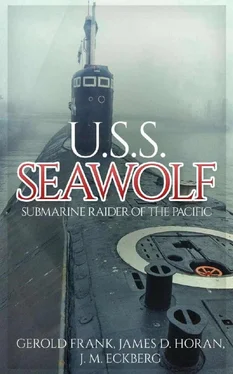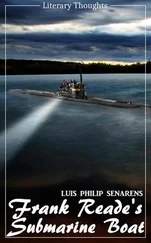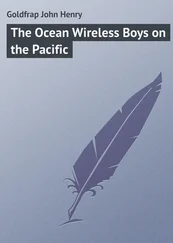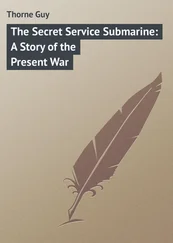“Well, here goes, honey,” I said.
“Oh, Mel,” she said. I leaned down and kissed her. She turned the wheel sharply and drove off. I came aboard the Wolf as a voice boomed through a megaphone from the bridge: “Preparations for getting under way!”
There was a terrific roar from deep within the Wolf ; then a series of sharp, ear-splitting reports, like a 20-mm. gun firing. Her powerful Diesels were turning over.
From the bridge, the same booming voice: “Stations for getting under way!”
The gangway was hauled in; the crew sprang to action.
“Take in No. 4!” came from the bridge. “Take in No. 4!” another voice echoed. The heavy two-inch lines were hauled in swiftly. They were brittle with ice, and they snapped and bit at the air as they were pulled in and fed hand over hand through a hatch into the after-torpedo room.
“Take in No. 3!” came the order, and “Take in No. 3!” came the echo.
The crew worked as one man; the Captain took his place on the bridge. As Line No. 1 was loosened and pulled in, the stationary colors were brought down, the running colors climbed up the mast. The Wolf was free of everything that held her to the land.
Her engines purred. Thick black smoke poured from the exhausts along the waterline.
The familiar odor of burned fuel oil came to me, and the old excitement swept over me. I hurried into the radio shack; I put on my earphones; the intercommunication system was switched on, and all through the Wolf ’s compartments little grilled loud-speakers awoke and chattered. When the Captain went into the conning tower, not a whisper of his but echoed through the ship. We were all one family, all wrapped together in that extraordinary intimacy of men who go down to the sea in the sealed steel chambers of a submarine.
The good-byes rang out in the crisp air. The Wolf ’s engines raced into a deafening roar. Slowly, stern first, streams of white water pouring from her sides and into the darker waters of the bay, she slid away from the dock and into the channel.
Engines thundering now, we cleared the outer harbor. We neared the Isle of Shoals, where the Squalus met her doom.
“Rig for dive.” Captain Warder’s order was almost casual.
“Rig for dive” ran tinnily through the boat. From stern to bow men leaped to their stations, spinning wheels, pulling controls, bracing themselves against valves. For a full ten minutes men investigated, inspected, tested, readying the Wolf for her dive.
Lieutenant Holden’s deep bass voice echoed through the intercommunications. “Main induction has been tested, bow and stern planes tested, safety flooded, sir.”
“Very well,” came Captain Warder’s voice. “Stand by to dive.”
“Stand by to dive,” echoed back.
Two sharp blasts of the diving alarm. Slowly, like some prehistoric aquatic monster, the Seawolf buried her nose in the water, and, moving ever forward, nudged her way deeper, deeper, until the waters closed over her and she vanished from sight.
We wasted no time putting the Wolf through her paces. Drill followed drill, dive followed dive. We had to anticipate every emergency. We assumed the Wolf was in a collision; that she had caught on fire; that she was being shelled; that her hull had been stove in; that she was being depth charged. In a practice dive off the Isle of Shoals, the drill order came: “Power gone on the bow and stern planes. Shift to hand.” We were assuming that our electrical power had suddenly gone, and that the boat had to be taken down by manual power alone. The bow- and stern-planes men instantly shifted to hand operation, maneuvering the planes by means of the huge wheels, each as wide as two men abreast. But within thirty seconds Dishman, on the bowplanes, shouted, “I can’t hold her!” Strongest man on the boat, his tremendous back muscles stood out and perspiration poured down his sides as he struggled with the wheel. The Wolf was knifing her way downward so swiftly that the water pressure made it impossible for him to shift the planes back. Two men leaped to his assistance. They couldn’t budge it. We were taking a terrific angle on the bow; the bowplanes were jammed at “hard dive,” and my chair began sliding forward. I clung to my desk. Captain Warder rushed down the control-room ladder.
“Blow No.1!” he ordered. The high-pressure air screamed into the tank, emptying it of water. Our eyes were glued to the depth gauge—90… 100… 150… 170 feet… We braced ourselves. We had only 230 feet of water here. The Squalus flashed through my mind. If we were to strike a rock ledge on the bottom…
Captain Warder, his eyes darting from the gauge to the men straining frantically at the wheel and back again, snapped: “ Blow everything!”
We were emptying every tank we had!
Still the Wolf went down. 180 feet… 200 feet…
“All back, emergency!”
It was the order to reverse propellers—the last resort of a submarine captain. “All back, emergency!” echoed over the phones from the maneuvering space.
The Seawolf shuddered. Slowly she checked her descent. Slowly, as her propellers bit into the water and pulled the stern down, she came to an even keel. My chair began sliding back. But now the Wolf began to rise, faster and faster, until with terrific speed she popped out on the surface of the sea like a cork in a dishpan. Our eardrums clicked. Fog set in through the ship as the water in the air expanded in the lowered pressure. We peered hazily at each other.
“Open the hatch!”
The fresh air rushed in.
Someone said, “Christ, I was wondering if I was ever going to smell that filthy stuff again!”
We breathed deeply. We had been down far, and now we were up; and the Wolf was still as good as new.
The Wolf ’s shakedown cruise—to shake down or shake out the bugs in her system—began April 12, 1940. From Portsmouth to Galveston, to Tampa, to Corpus Christi, to Cristobal, Canal Zone, to the Brooklyn Navy Yard, to Annapolis, and back to Portsmouth again—a two-months trip to test her under every possible condition.
At the same time the crew was put to the test. We grew to know each other better, to learn each other’s habits of work.
Teamwork is the essence of a submarine, and only by endless and incessant practice through one maneuver to another can a crew acquire perfection, so that they can tumble out of their bunks and click into split-second precision almost the instant an alarm sounds. Each of us became letter-perfect in our stations. Before, in our training periods, we had learned to know the Wolf —every cubbyhole, every cable. Now we learned to mesh together.
Our stations, our duties, were as clear-cut as the assignments given a crack football team in a championship game. Life was the title we were fighting for, and death always lurked as the penalty for a man who wasn’t where he should be, for a man offside. We couldn’t afford to make mistakes, and officers and men moved, transferred, replaced each other, with clockwork regularity.
Lieutenant Holden, engineering officer, dove the boat and was in charge of all machinery. Ensign Mercer, communications officer, decoded messages, handled confidential publications, was ordered to guard with his life the Wolf ’s secret U.S. Navy codebook.
Sousa, chief petty officer, was liaison man between officers and enlisted men. We learned that Ensign Casler was a poor cribbage player, but an expert navigation officer; that Dishman rarely failed in an emergency; that Sully had a knack for baking cakes; that Loaiza was always complaining that he was afraid and always proving the opposite. We grew to know Captain Warder, to learn how precise and accurate a technician he was, and how human.
Читать дальше






![Hubert Bancroft - The Native Races [of the Pacific states], Volume 5, Primitive History](/books/749157/hubert-bancroft-the-native-races-of-the-pacific-s-thumb.webp)

![Hubert Bancroft - The Native Races [of the Pacific states], Volume 1, Wild Tribes](/books/750126/hubert-bancroft-the-native-races-of-the-pacific-s-thumb.webp)



![Edward Ellis - Adrift on the Pacific - A Boys [sic] Story of the Sea and its Perils](/books/753342/edward-ellis-adrift-on-the-pacific-a-boys-sic-s-thumb.webp)